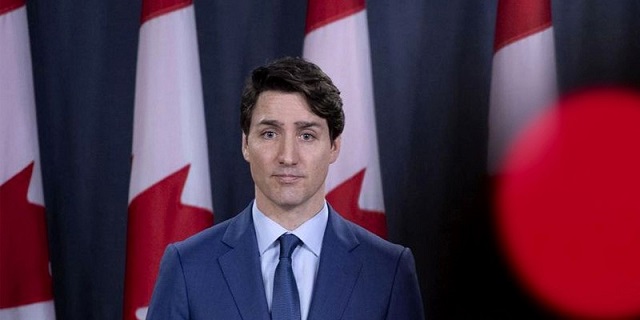Economy
Trudeau’s bureaucrat hiring spree is out of control

From the Canadian Taxpayers Federation
Author: Franco Terrazzano
Bureaucrats love to think of themselves as “public servants,” but who is really serving who around here?
Prime Minister Justin Trudeau added another 10,525 bureaucrats to the taxpayer payroll last year. Since becoming prime minister, Trudeau has added more than 108,000 new federal bureaucrats.
That’s a 42 per cent increase in the federal bureaucracy in less than a decade.
Ask yourself, are you getting 42 per cent better services from the federal government? Unless your paycheque comes from taxpayers, the answer is a big fat NO.
While Trudeau’s bureaucracy grew by 42 per cent, Canada’s population grew by 14 per cent.
That means there would be 72,491 fewer federal paper pushers had Trudeau kept growth in the bureaucracy in line with population growth.
It’s not just the size of the bureaucracy that’s ballooning – the cost is too.
The total cost of the federal payroll hit $67 billion last year, a record high. That’s a 68 per cent increase over 2016.
Trudeau gave federal bureaucrats more than one million pay raises in the last four years alone.
Since taking office, Trudeau also rubberstamped about $1.4 billion in taxpayer-funded bonuses to bureaucrats working in federal departments.
The bonuses were paid out despite the Parliamentary Budget Officer finding “less than 50 per cent of [performance] targets are consistently met.”
Then there’s the bonuses at failing Crown corporations.
CBC dished out $15 million in bonuses last year, while their President and CEO Catherine Tait whined about “chronic underfunding” and begged the government for more taxpayer cash. The CBC takes more than $1 billion from taxpayers every year.
The Canada Mortgage and Housing Corporation dished out $102 million in bonuses over the last four years, while Canadians couldn’t afford to buy a home. The bonuses rained down, despite the CMHC repeatedly claiming it’s “driven by one goal: housing affordability for all.”
The Bank of Canada dished out more than $60 million in bonuses over the last three years, even though it failed to do its one and only job: keep inflation low and around two per cent.
The average annual compensation for a full-time federal bureaucrat is $125,300, when pay, pension and perks are accounted for, according to the PBO.
There are now more than 110,000 federal bureaucrats taking home a six-figure base salary – an increase of 154 per cent since Trudeau took power.
Meanwhile, data from Statistics Canada suggests the average annual salary among all full-time workers in Canada was less than $70,000 in 2023.
Here’s why all this matters:
First, it’s an issue of fairness. The last few years have spelled hardship for Canadians who don’t work for the government, but do pay the bills.
Countless Canadians were sent to the ranks of the unemployed, lost their business and struggled to afford rising rents and costly grocery trips.
They’re paying higher taxes so more highly-paid bureaucrats can take bigger paycheques.
Second, more than half of the federal government’s day-to-day spending is consumed by the bureaucracy. That means any government that wants to fix the budget dumpster fire must shrink the bureaucracy.
Let’s recap:
Taxpayers paid for 108,000 new federal bureaucrats. Taxpayers paid for more than one million pay raises over the last four years. Taxpayers paid for more than $1 billion in bonuses.
And bureaucrats barely meet even half of their performance targets – targets they set for themselves.
It’s clear Trudeau’s bureaucratic bloat isn’t serving taxpayers. It’s time to find a pin and pop Ottawa’s ballooning bureaucracy.
This column was first published in the Western Standard on July 202, 2024.
Automotive
Federal government should swiftly axe foolish EV mandate

From the Fraser Institute
Two recent events exemplify the fundamental irrationality that is Canada’s electric vehicle (EV) policy.
First, the Carney government re-committed to Justin Trudeau’s EV transition mandate that by 2035 all (that’s 100 per cent) of new car sales in Canada consist of “zero emission vehicles” including battery EVs, plug-in hybrid EVs and fuel-cell powered vehicles (which are virtually non-existent in today’s market). This policy has been a foolish idea since inception. The mass of car-buyers in Canada showed little desire to buy them in 2022, when the government announced the plan, and they still don’t want them.
Second, President Trump’s “Big Beautiful” budget bill has slashed taxpayer subsidies for buying new and used EVs, ended federal support for EV charging stations, and limited the ability of states to use fuel standards to force EVs onto the sales lot. Of course, Canada should not craft policy to simply match U.S. policy, but in light of policy changes south of the border Canadian policymakers would be wise to give their own EV policies a rethink.
And in this case, a rethink—that is, scrapping Ottawa’s mandate—would only benefit most Canadians. Indeed, most Canadians disapprove of the mandate; most do not want to buy EVs; most can’t afford to buy EVs (which are more expensive than traditional internal combustion vehicles and more expensive to insure and repair); and if they do manage to swing the cost of an EV, most will likely find it difficult to find public charging stations.
Also, consider this. Globally, the mining sector likely lacks the ability to keep up with the supply of metals needed to produce EVs and satisfy government mandates like we have in Canada, potentially further driving up production costs and ultimately sticker prices.
Finally, if you’re worried about losing the climate and environmental benefits of an EV transition, you should, well, not worry that much. The benefits of vehicle electrification for climate/environmental risk reduction have been oversold. In some circumstances EVs can help reduce GHG emissions—in others, they can make them worse. It depends on the fuel used to generate electricity used to charge them. And EVs have environmental negatives of their own—their fancy tires cause a lot of fine particulate pollution, one of the more harmful types of air pollution that can affect our health. And when they burst into flames (which they do with disturbing regularity) they spew toxic metals and plastics into the air with abandon.
So, to sum up in point form. Prime Minister Carney’s government has re-upped its commitment to the Trudeau-era 2035 EV mandate even while Canadians have shown for years that most don’t want to buy them. EVs don’t provide meaningful environmental benefits. They represent the worst of public policy (picking winning or losing technologies in mass markets). They are unjust (tax-robbing people who can’t afford them to subsidize those who can). And taxpayer-funded “investments” in EVs and EV-battery technology will likely be wasted in light of the diminishing U.S. market for Canadian EV tech.
If ever there was a policy so justifiably axed on its failed merits, it’s Ottawa’s EV mandate. Hopefully, the pragmatists we’ve heard much about since Carney’s election victory will acknowledge EV reality.
Economy
The stars are aligning for a new pipeline to the West Coast

From Resource Works
Mark Carney says another pipeline is “highly likely”, and that welcome news.
While attending this year’s Calgary Stampede, Prime Minister Mark Carney made it official that a new pipeline to Canada’s West Coast is “highly likely.”
While far from a guarantee, it is still great news for Canada and our energy industry. After years of projects being put on hold or cancelled, things are coming together at the perfect time for truly nation-building enterprises.
Carney’s comments at Stampede have been preceded by a number of other promising signs.
At a June meeting between Carney and the premiers in Saskatoon, Alberta Premier Danielle Smith proposed a “grand bargain” that would include a privately funded pipeline capable of moving a million barrels of oil a day, along with significant green investments.
Carney agreed with Smith’s plan, saying that Canada needed to balance economic growth with environmental responsibility.
Business and political leaders have been mostly united in calling for the federal government to speed up the building of pipelines, for economic and strategic reasons. As we know, it is very difficult to find consensus in Canada, with British Columbia Premier David Eby still reluctant to commit to another pipeline on the coast of the province.
Alberta has been actively encouraging support from the private sector to fund a new pipeline that would fulfil the goals of the Northern Gateway project, a pipeline proposed in 2008 but snuffed out by a hail of regulations under former Prime Minister Justin Trudeau.
We are in a new era, however, and we at Resource Works remarked that last month’s G7 meeting in Kananaskis could prove to be a pivotal moment in the history of Canadian energy. An Ipsos poll found that Canada was the most favoured nation for supplying oil in the G7, and our potential as an energy superpower has never been more important for the democratic world, given the instability caused by Russia and other autocratic energy powers.
Because of this shifting, uncertain global climate, Canadian oil and gas are more attractive than ever, and diversifying our exports beyond the United States has become a necessity in the wake of Donald Trump’s regime of tariffs on Canada and other friendly countries.
It has jolted Canadian political leaders into action, and the premiers are all on board with strengthening our economic independence and trade diversification, even if not all agree on what that should look like.
Two premiers who have found common ground are Danielle Smith and Ontario Premier Doug Ford. After meeting at Stampede, the pair signed two memorandums of understanding to collaborate on studying an energy corridor and other infrastructure to boost interprovincial trade. This included the possibility of an eastward-bound pipeline to Ontario ports for shipping abroad.
Ford explicitly said that “the days of relying on the United States 100 percent, those days are over.” That’s in line with Alberta’s push for new pipeline routes, especially to northwestern B.C., which are supported by Smith’s government.
On June 10, Resource Works founder and CEO Stewart Muir wrote that Canadian energy projects are a daunting endeavour, akin to a complicated jigsaw puzzle, but that getting discouraged by the complexity causes us to lose sight of the picture itself. He asserted that Canadians have to accept that messiness, not avoid it.
Prime Minister Carney has suggested he will make adjustments to existing regulations and controversial legislation like Bill C-69 and the emissions cap, all of which have slowed the development of new energy infrastructure.
This moment of alignment between Ottawa, the provinces, and other stakeholders cannot be wasted. The stars are aligning, and it will be a tragedy if we cannot take a great step into the future of our country.
-

 Crime2 days ago
Crime2 days ago“This is a total fucking disaster”
-

 Fraser Institute1 day ago
Fraser Institute1 day agoBefore Trudeau average annual immigration was 617,800. Under Trudeau number skyrocketted to 1.4 million annually
-

 International2 days ago
International2 days agoChicago suburb purchases childhood home of Pope Leo XIV
-

 MAiD2 days ago
MAiD2 days agoCanada’s euthanasia regime is already killing the disabled. It’s about to get worse
-

 Daily Caller2 days ago
Daily Caller2 days ago‘I Know How These People Operate’: Fmr CIA Officer Calls BS On FBI’s New Epstein Intel
-

 Daily Caller2 days ago
Daily Caller2 days agoBlackouts Coming If America Continues With Biden-Era Green Frenzy, Trump Admin Warns
-

 Red Deer1 day ago
Red Deer1 day agoJoin SPARC in spreading kindness by July 14th
-

 Business1 day ago
Business1 day agoPrime minister can make good on campaign promise by reforming Canada Health Act





